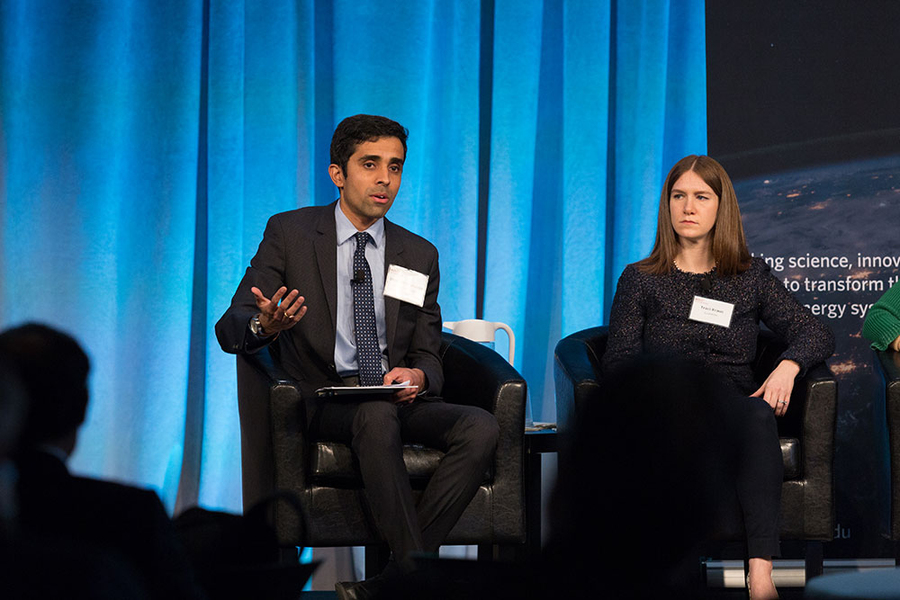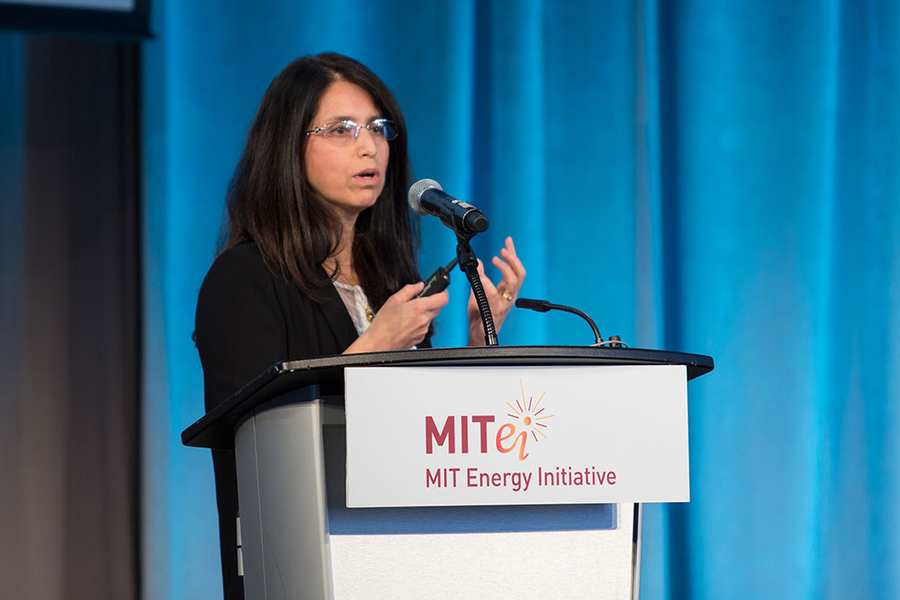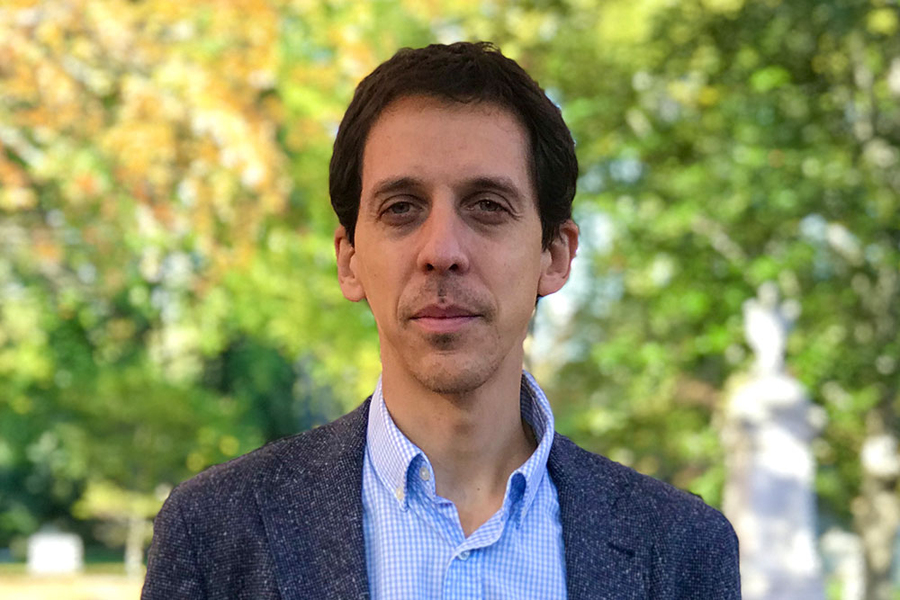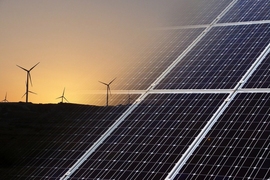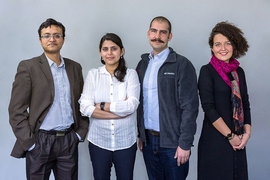Pablo Duenas-Martinez and Dharik Mallapragrada first met on opposite sides of a sponsored research project through the MIT Energy Initiative (MITEI). They worked together to define a project to study the long-term evolution of the electricity sector in India and the impacts of technological and policy drivers. Duenas-Martinez guided the research direction on MITEI’s end, and Mallapragada provided input from an industry perspective.
Mallapragada, who earned his PhD in chemical engineering from Purdue University, had been working in the energy and petrochemical sector for about five years at two different companies when he came to a realization.
“As I took on a bunch of different roles at the companies, I came to realize the connections between the applied research I was pursuing and the policy implications in the context of decarbonizing energy systems, but somehow the framing of the problems I was investigating didn’t sit right with me,” he says. He came to MIT because he wanted to think about the issue in broader terms. “The main challenge in my mind is to address economy-wide decarbonization while simultaneously expanding access to energy. It is not just the end state, but the entire trajectory of this transition that matters. I think everybody recognizes what the end goal is. But there are no real clear pathways that have been identified, and I’ve been eager to contribute toward addressing the gaps in this area of energy research.”
At MITEI, Mallapragada utilizes his engineering training and industry background while learning about all the other elements that are necessary to be able to address the grand challenge of decarbonization, which he describes as “really very multidisciplinary in terms of scope and applications.”
Mallapragada joined fellow research scientists Duenas-Martinez and Karen Tapia-Ahumada at the Electric Power Systems (EPS) Center, one of MITEI’s Low-Carbon Energy Centers. The center unites MIT researchers, faculty, and students to accelerate the transition to a clean electric power sector. The center’s mission is threefold:
- to examine the impacts of emerging technologies, business models, regulatory frameworks, and policy dynamics;
- to investigate solutions ranging from developing new analytical tools for improved decision-making in the industry to vetting breakthrough technologies; and
- to serve as a convening entity to engage industry and policymakers and provide thought leadership through rigorous analysis of the clean energy transition.
Steering EPS Center projects
Mallapragada, Duenas-Martinez, and Tapia-Ahumada all bring a wealth of experience to their roles as the researchers who shape the direction of EPS Center projects. Mallapragada, the newest addition to the team, credits his previous work in the energy industry and personal experience working with academia on sponsored projects with helping him to “hit the ground running” at MITEI, in terms of engaging with research sponsors and guiding projects.
“Oftentimes, research scientists become conduits for communication within an organization. Our research helps people from different sides of the business engage with each other in new ways,” says Mallapragada. “Our role is not just to do the research, but actually to persuade people to think about problems and challenges in new ways, using evidence generated from modeling and analysis.”
Duenas-Martinez is no stranger to helping people in different sectors — from power and gas utilities to government and regulatory agencies — think outside the box to improve energy systems around the world.
He grew up in Madrid, where he obtained his bachelor’s degree in industrial engineering, a master’s in electric power systems, and a doctorate in electrical engineering at Comillas Pontifical University. He first came into contact with MIT during his PhD work in 2012, before joining MITEI as a postdoc in 2014. “I also received a bachelor’s in economics from a distance learning university two years ago,” he says.
A number of his projects touch on the impacts of natural gas on the electric power system, but his work has started moving in a different direction. “Lately, I’ve been working on the security of energy supply and researching the distribution side and all the changes that are happening in the electric power system,” says Duenas-Martinez.
Tapia-Ahumada, an electrical engineer, joined MITEI as a postdoc in 2011 and became a research scientist in 2014, but she has been at MIT for far longer. Like Mallapragada and Duenas-Martinez, her journey to MITEI spans years and continents. She grew up in Chile and came to MIT in 2003 after living and working in Argentina following her graduation from the Pontifical Catholic University of Chile.
While her husband pursued his MBA, Tapia-Ahumada was accepted into MIT’s Technology and Policy Program, where she completed her graduate degree and continued on to earn her PhD in engineering systems.
“I did both my master’s and PhD while I was having my kids — so I finished everything all at once,” she says. Tapia-Ahumada completed postdoc work at MIT and finally landed at MITEI as a research scientist. “It has been a long and a rewarding road for me here at MIT,” she says.
Tapia-Ahumada’s research interests include the operation and planning of electric power systems, renewable energy generation, distributed energy resources, and the market and regulatory structures required to support the development of sustainable energy systems.
Roles at MITEI
Mallapragada, Duenas-Martinez, and Tapia-Ahumada manage separate projects and teams within the EPS Center’s portfolio, but they utilize their different backgrounds to work toward the common goal of implementing widespread electricity access while decarbonizing the electric power sector.
They each define their role slightly differently.
“In some ways, I play the role of a principal investigator on a research project, while also being fairly hands-on with the research — not only doing some of it, but also defining what the research objectives are and then working with students to meet the research goals,” says Mallapragada. He notes that he primarily works with graduate students from MIT’s Technology and Policy Program.
Duenas-Martinez concurs with Mallapragada, adding that establishing and managing the human capital for a project is a major part of sponsored research projects. “Sometimes we work together with a postdoc or a student — and sometimes, as in the cases of both Karen and me, we have even been the postdoc or the student on the project,” he says.
Of equal importance, he says, is working with international students. Students from around the world often contact MITEI research scientists about topics of interest, and MITEI will invite them to come work on a project to help enrich the EPS Center’s work with outside ideas.
They also work with “UROPs” — students who receive funding through MIT’s vast Undergraduate Research Opportunities Program, which connects students with faculty to work on new or established research projects. “My experience with UROP students has always been great,” says Duenas-Martinez. “They are motivated and very, very smart.”
Tapia-Ahumada explains that they are all very hands-on when it comes to helping students succeed. “We [research scientists] are all developing particular modeling tools, so we know the details of the tools, and then when we bring on students, we are starting from scratch. They need the extra push from us at the beginning to learn how to set up and run the models, and then, once they are up to speed, we supervise their research throughout the course of the project,” she explains.
The three research scientists also regularly serve as advisors for master’s theses, and work with postdocs to help them figure out where they’d like to end up post-MITEI.
The EPS Center researchers do not work in fixed groups on every project. In fact, Mallapragada feels fortunate to have been part of quite a few different teams working on MITEI projects. “I’ve been able to build my own network that spans across MIT, rather than having a team that I work with on a day-to-day basis. I’m kind of like a puzzle piece that fits in wherever I’m needed,” he says.
Tapia-Ahumada observes that research scientists act as a link between professors and particular projects. “Sometimes the professors provide the high-level ideas, and then we are there to help work out the smaller details of the project,” she notes.
Mallapragada says MITEI research scientists help faculty by providing greater context to, and perspective on, the fundamental research that may be happening within academic departments. “We don’t necessarily operate within the realm of technology development or fundamental science research ourselves, but we help faculty contextualize the work they are doing and make it appealing to an industrial sponsor, who may not otherwise be thinking about these issues from a long-term perspective. That is something that has an appeal not only within the electric power systems sector, but also across all the end-use sectors,” he says. “We fit into the technology development pipeline as a contact center for defining what topics need to be focused on by industry, policymakers, and academia in order to accelerate the sustainable energy transition.”
Research highlights and planned trajectories
Of the many projects they’ve participated in at MITEI, a few remain highlights. Duenas-Martinez counts MITEI’s 2016 Utility of the Future study as a particular favorite. The study addressed the technology, policy, and business models that are shaping the evolution of the delivery of electricity services.
“We were on the cutting edge of knowledge. We were doing some really deep analysis of what’s going to happen in the next few years, with all the transformation that is happening in the electric power systems,” says Duenas-Martinez. “This was a consortium project, which was something very new for me. We had 10 companies involved and also an expert advisory board, so there were long discussions with large groups about very hot topics at the time, and it was a great learning experience because I was new. It was so rewarding.”
One of Tapia-Ahumada’s favorite projects focused on Iceland. “It was fascinating because of the topic itself. Iceland’s energy is almost 100 percent renewable, so it was very interesting to learn about some of the challenges they are facing in order to ensure the long-term security of electricity supply in an economic manner while preserving environmental goals.” She also enjoyed having the opportunity to work with both Duenas-Martinez and colleagues from Comillas Pontifical University in Spain. “It was an international group of people working on a very relevant topic,” she says.
Tapia-Ahumada, along with Ignacio Pérez-Arriaga, a visiting professor from Comillas Pontifical University, also worked on a MITEI Seed Fund project with Mei Yuan, a research scientist at the Joint Program on the Science and Policy of Global Change. They developed an integrated framework that combined electricity and economic modeling with policy analysis of carbon cap-and-trade, renewable portfolio standards, and other energy and climate mechanisms used in the United States. Tapia-Ahumada says she found the project rewarding because it allowed the researchers to decide how to expand their modeling tools and determine which scenarios to analyze.
Mallapragada came on board with MITEI as part of a sponsored research project looking into the factors likely to impact the delivered cost of electricity in future low-carbon grids and the role for emerging technologies like battery energy storage. He considers it to be a highlight of his time at MITEI. “The fairly broad project scope meant that I had significant autonomy in terms of refining the research questions and approach, and it led us to identify some interesting insights on the long-term value of battery energy storage in power systems,” he says. He plans to continue pursuing research on the role that hydrogen will play in the future clean energy system — a question that has been of increasing importance during his time at MITEI. “I’ve seen a clear, increasing emphasis on opportunities for clean hydrogen, and I’ve been fortunate to get involved with a few projects, some of which have been published, but others for which the results will be coming along within the next year or so.”
According to Duenas-Martinez, the majority of the changes happening in the electric power sector are happening at the consumer level. He plans to explore how the adoption of new technologies and distributed resources is going to impact the power system in general. “I want to know how energy communities will migrate to new technologies and how consumer empowerment and choice enter into the equation. What will the future of our electric power system look like?” he asks.
“The work that we are doing at MITEI is very wide in scope, and our focus on the electric power system also encompasses electrification, which involves other sectors of the economy,” adds Tapia-Ahumada. “We are thinking hard about how to expand our research scope to incorporate other sectors, such as energy-intensive heating and transportation.”
She aims to better understand the economic signals that consumers receive and the effects of electricity retail prices. “We are exploring how the retail price of electricity could be set to result in an efficient economic response — and how on-site energy generation will affect electricity consumption.”
Tapia-Ahumada adds that she thinks of herself as a bridge between research methodology and real-world applications. “We have many methodologies, but then we need to find the right sort of abstraction in order for us to develop appropriate tools that can produce meaningful results, and then find ways to communicate those findings to nontechnical audiences so they can understand the potential applications and various pathways.”
In addition to being a research scientist, Tapia-Ahumada is MITEI’s digital learning fellow, a new role at MITEI that means she is responsible for helping develop and implement MITEI’s online course curriculum.
Researching through a pandemic
Of course, learning and research in the age of Covid-19 looks a bit different, especially for those with children at home.
“We are researchers, but we are also primarily parents of kids of various ages,” says Mallapragada. “My own personal experience has been that, on the face of it, the pandemic seems like something you can handle — but as the weeks have gone by, the situation has evolved, just like the disease.” While he is grateful for the extra time with his son, it seems like the rest of the world has “kind of normalized,” he notes.
“It’s not that anybody’s pressuring you to do things, but it’s just that you also want to normalize and work at your pre-Covid-19 pace. And so you’re kind of torn in different directions,” he says. “I feel like in some ways, it has been a lot harder now than in the beginning, when maybe you were thinking of this as a short-term thing that would soon evolve into something that resembles normalcy. So — I have mixed feelings. Obviously, there are good days and bad days,” reflects Mallapragada.
“I think we’re all parents here, so we have some personal situations at home to deal with, and we’ve also been enjoying the extra family time, but I will say that research-wise, we haven’t really scaled back much,” says Duenas-Martinez. “We have all been working equally as hard at home as when we were at the office. There are long nights, weekends are like weekdays, but overall, it’s been pretty good.”
“For me, the transition has been okay,” says Tapia-Ahumada. “My boys are already teenagers. They are very independent and they’re close in age, so they keep themselves busy.”
Tapia-Ahumada also says there has been no difference when it comes to working with research sponsors. For example, she has been working with a sponsor since before the pandemic hit that is based in both San Francisco and China.
“Before the Covid crisis, we were working with them remotely, so there have been no changes there. It has been good; they have kept collaborating with us. And they are also very conscious of our time constraints,” she says. “Everyone has been flexible, which helps because I think we’re all in the same boat — everyone understands that we have family commitments and some things that we didn’t foresee. But it’s been good. With research you always keep going — it’s never-ending.”
Energy access and communications challenges
The three also offer insights into what they consider to be the most important challenges to solve in the energy space. While decarbonization is certainly an urgent issue, the team also considers expanded energy access and the accessible, effective communication of research findings to be other major obstacles to overcome.
Duenas-Martinez says he remains focused on the long-term outlook for energy systems and on other critical problems, including how to provide reliable and affordable electricity to those who are still without power. “We still have about 1 billion people without access to good electricity. This is one topic that MITEI is focused on: We are working with the Universal Energy Access Lab to facilitate energy access to those around the globe,” says Duenas-Martinez. “We have been developing tools and we are in close contact with multilateral organizations, and governments and authorities from different countries to try to make this transformation possible.”
Another major barrier to the clean energy transition is the lack of a common language within academia. “I have different styles for working with electrical engineers versus economists. It’s very challenging to find a common language so that multidisciplinary teams can understand each other,” says Tapia-Ahumada.
In addition, it’s hard to get the research into the hands of those who can do something with it and effect real change, such as policymakers and the general public. “How do we communicate with lay people and policymakers in order for them to understand the need for decarbonization, where we are trying to go, and what we are trying to accomplish?” she asks.
Duenas-Martinez adds that he is always taken aback by how hard it is to explain what is going on in the energy world to the general public and to combat preconceived notions and pervasive misinformation: “There are many hot topics, starting with decarbonization and local air pollution, where people already have pieces of information — but it’s not always the correct information, and it has surprised me how difficult it is to explain the reality and help them to see the fuller energy picture.”
Mallapragada, too, is focused on engaging with academia, industry, policymakers, and the public in a meaningful way. “There’s an increasing demand from society for science to be relevant to social issues and making that connection — so what may not have been part of the job description of a scientist previously is now a significant part of our role. It’s not just about doing good research and publishing papers, but there is the added responsibility to take the extra step to communicate the findings effectively and in a nuanced way,” says Mallapragada.
Working the clean energy transition
Finding the balance between solving energy problems and being realistic about the best paths forward can also be a challenge.
“At the end of the day, I want to be a constructive contributor in solving climate and energy challenges. And sometimes the constructive contributor has to be the one to say, ‘Hey, we don’t have all the answers, and we need to pump the brakes. Otherwise, we might end up going down a path that we may not like down the road,’” says Mallapragada.
“We know that 2050 is the target that everyone has in mind for reaching our decarbonization goals,” adds Tapia-Ahumada. “If we are to make a successful energy transition, electricity prices will be key. We’ll keep working on our simulation tools. They are not going to be the final answer, but they will identify the various pathways that the energy or electricity sector may take. This information is going to be useful for regulators, utilities, and other stakeholders working on the transition.”
As the world continues to work toward a sustainable energy future, Duenas-Martinez says MITEI researchers will offer a set of solutions that could help move us down the path, but not dictate the path itself.
“We are not here to say what should be done. We are more here just to provide food for thought,” says Duenas-Martinez. “We are doing the analysis, we are testing different scenarios, we are innovating and developing lots of solutions. We don’t know which solution is the best one, but we are doing the best we can to try to improve our future by providing industry and policy makers with the tools to solve our energy challenges.”
This article appears in the Autumn 2020 issue of Energy Futures, the magazine of the MIT Energy Initiative.
